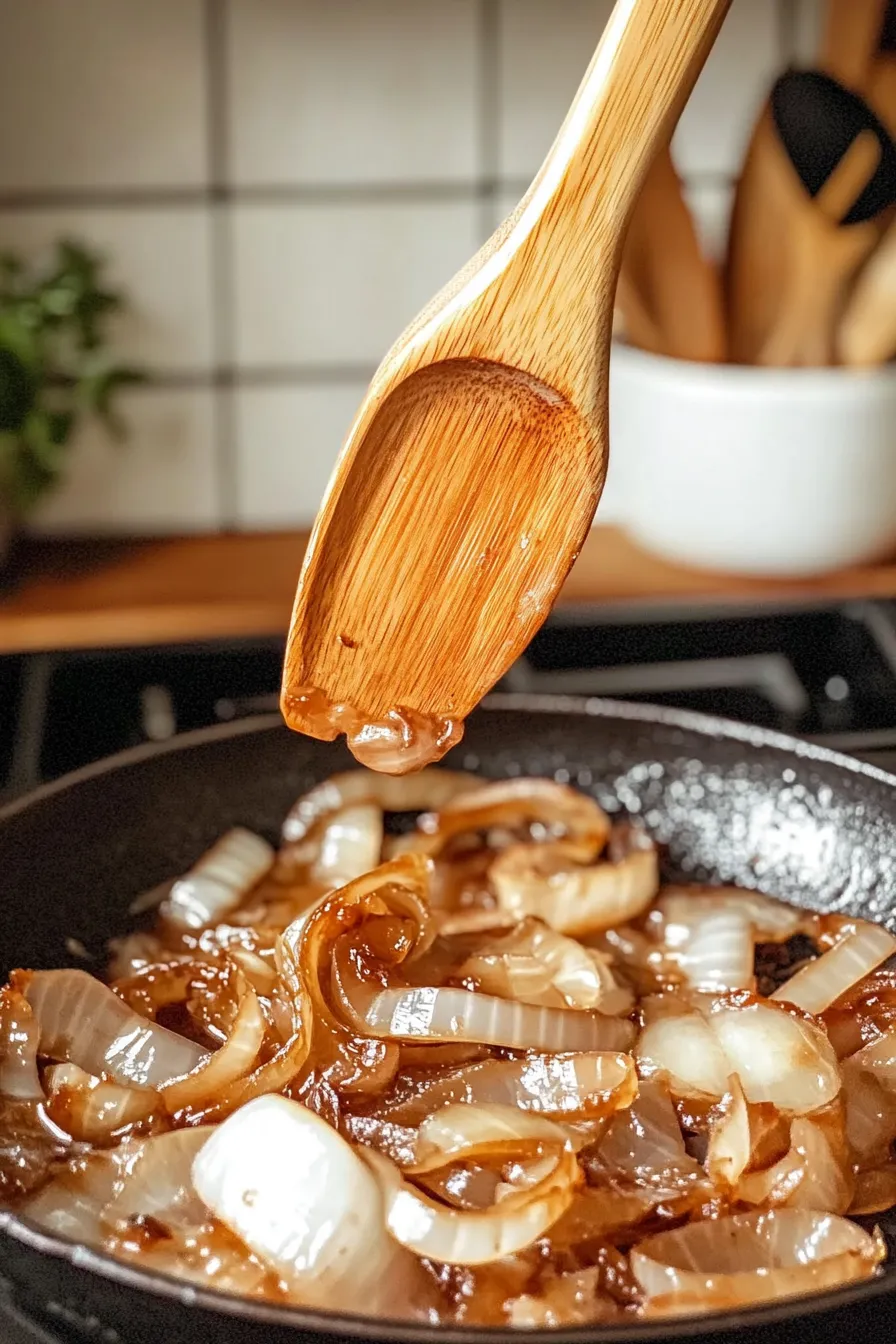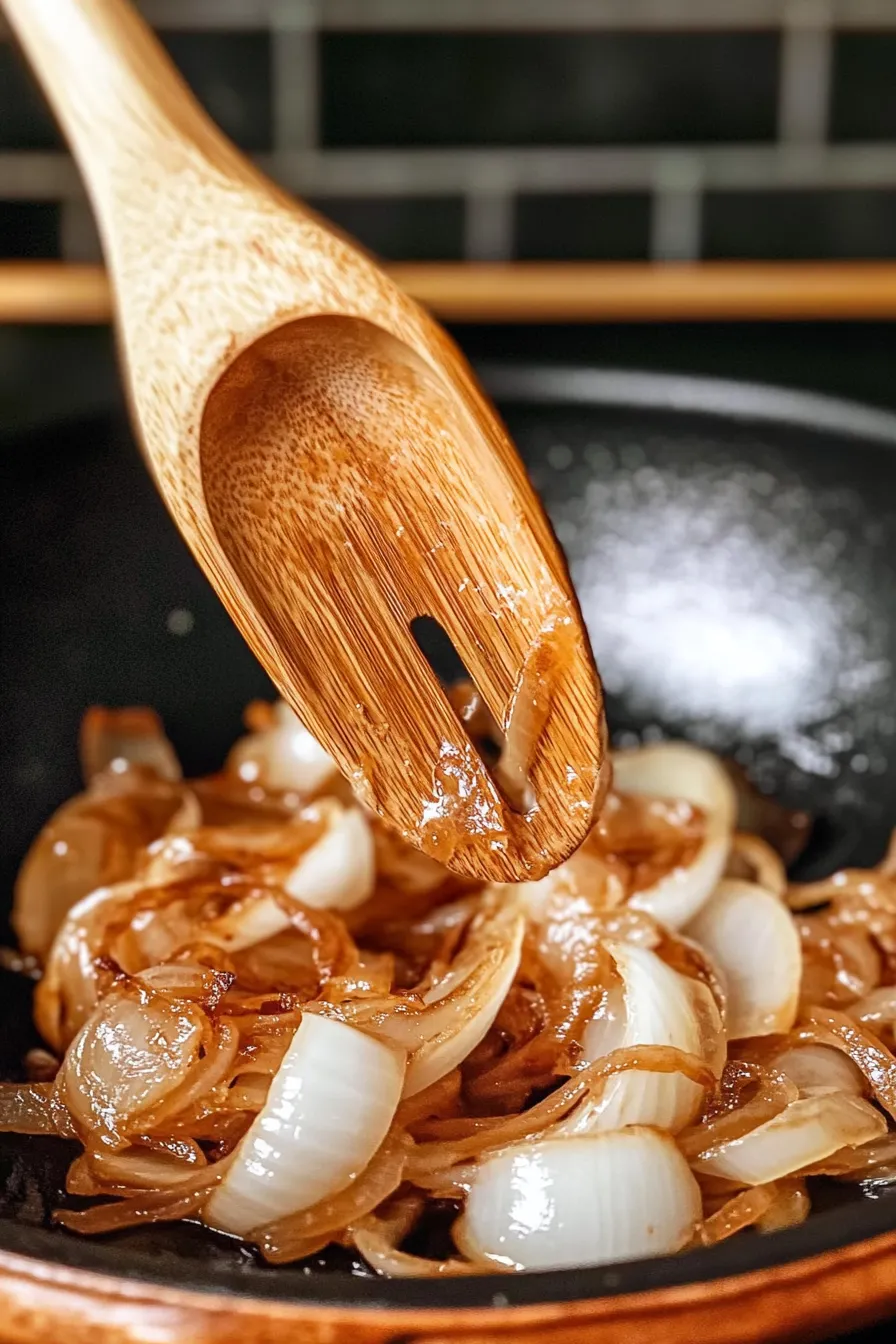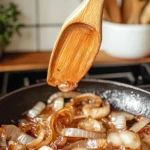How to Caramelize Onions for Perfect Flavor Every Time

Are you ready to elevate your cooking game? Learning the art of caramelizing onions is a delightful journey that transforms simple ingredients into a rich, flavorful addition to countless dishes. This technique unlocks the natural sweetness of onions, turning them golden brown and adding a luscious depth to everything from burgers to soups. Whether you’re a seasoned chef or a curious home cook, mastering this skill will enhance your culinary repertoire and impress your dining companions.
Moreover, knowing how to achieve perfectly caramelized onions can save you time and effort in the kitchen. With just a few simple steps and a bit of patience, you’ll discover how to turn everyday meals into gourmet experiences. This guide will share essential tips and tricks on caramelizing onions, ensuring that you get that ideal caramelization. So, grab your skillet and let’s dive into the sweet world of golden goodness that awaits you!
Essential Ingredients for How to Caramelize Onions:
Caramelizing onions is a culinary technique that enhances their natural sweetness, resulting in a rich and flavorful addition to many dishes. To achieve perfect caramelized onions, you will need the following essential ingredients:
– 2–3 large yellow or sweet onions: Opt for yellow onions for a balanced sweetness, or use sweet onions like Vidalia for an even richer flavor.
– 2 tablespoons butter or oil (or a mix): Butter adds a creamy taste, while oil can provide a higher smoke point. A combination of both can yield the best results.
– A pinch of salt: This helps draw out the moisture from the onions and enhances their natural flavors.
– Optional: Water, broth, or wine for deglazing: This can be added during cooking to lift any fond from the pan, adding extra depth to your caramelized onions.
Steps to Perfectly Caramelize Onions
Begin by slicing your onions thinly. This ensures even cooking and maximizes their surface area, allowing for better caramelization. In a large skillet, heat your butter or oil over medium heat. Once hot, add the sliced onions and a pinch of salt. Stir them gently to coat with the fat.
As the onions cook, they will soften and begin to turn translucent. Patience is key here! Allow them to cook slowly, stirring every 5-10 minutes, reducing the heat as necessary to prevent burning. This process can take anywhere from 20 to 40 minutes.
To deepen the flavor, consider deglazing the pan. If you have some broth, white wine, or even a splash of water on hand, add a tablespoon or two to the pan when the onions are a lovely golden-brown. Scrape up any delicious brown bits stuck to the bottom of the skillet; these contribute to the overall flavor profile.
Caramelized onions are versatile and can elevate many recipes. They add a savory touch to dishes such as vegetable pizza or can be used generously in gourmet burgers. Enjoy using these sweet, golden nuggets in your culinary endeavors!
For more cooking inspiration, like how to create a delightful Caramel Macchiato Tiramisu, don’t hesitate to explore our recipe collection!

Cooking Techniques to Achieve Perfectly Caramelized Onions:
Caramelizing onions is a straightforward yet transformative cooking technique that enhances their natural sweetness and adds depth to a wide array of dishes. Mastering this process can greatly elevate your culinary creations, whether you’re adding them to savory recipes or incorporating them into desserts. Here’s how to caramelize onions effectively.
Choosing the Right Onions
First, start with the right type of onions. Yellow onions are the most commonly used for caramelization due to their high sugar content. However, sweet onions like Vidalia can also create a deliciously rich flavor. Slice the onions uniformly to ensure even cooking.
Preparing the Pan and Heat
Next, select a heavy-bottomed skillet—cast iron or stainless steel works best. A thick base will distribute heat evenly, preventing hot spots. Heat the pan over medium to medium-low flame. Using too high a heat can burn the onions, while too low will prolong the cooking time unnecessarily.
Cooking Techniques to Caramelize Onions
Add a generous amount of butter or olive oil to your hot pan. For every large onion, use about one to two tablespoons of fat. Once the fat has melted, add the sliced onions and stir to coat them evenly. After a few minutes, reduce the heat to low. Stir them every few minutes, allowing them to cook slowly. This gradual process can take anywhere from 30 to 50 minutes, depending on the quantity and desired level of caramelization.
Enhancing Flavor with Seasonings
For an added depth of flavor, consider sprinkling on a bit of salt and sugar. Salt draws out moisture, while sugar enhances sweetness. Additionally, if you’re feeling adventurous, splash in a bit of balsamic vinegar or wine during the last few minutes of cooking for a sophisticated touch.
Incorporating caramelized onions into recipes can enhance the overall profile of your dish. For instance, they work beautifully in a vegetable pizza, creating a sweet and savory contrast that pleases the palate.
Once finished, the onions should be a deep golden brown, with a rich, sweet aroma that indicates their perfect caramelization. Enjoy them in various recipes or as a delicious topping for meats, burgers, or pastas!
Step-by-Step Guide on How to Prepare How to Caramelize Onions:
Caramelizing onions is an art that can truly elevate your dishes with a rich flavor. With just a few simple ingredients—2-3 large yellow or sweet onions, 2 tablespoons of butter or oil, a pinch of salt, and an optional splash of water, broth, or wine for deglazing—you’re on your way to creating something marvelous.
1. Slice the Onions
Begin by preparing your onions. Peel and trim the ends of the onions, then slice them thinly. Thin slices ensure quick and even cooking, allowing the sugars to release and caramelize beautifully. Aim for uniform pieces to promote consistent cooking.
2. Heat the Pan and Melt the Fat
In a large skillet, heat 2 tablespoons of butter or oil over medium heat. You can mix the two for added flavor and richness. Once the fat has melted and is sizzling, carefully add your sliced onions to the pan, turning them gently to coat with the melted fat.
3. Add a Pinch of Salt
Sprinkle a pinch of salt over the onions. This helps draw out moisture and promotes a better caramelization process. Stir the onions occasionally to prevent sticking and burning. Avoid cranking up the heat; slow and steady is key.
4. Keep Cooking
Continue to cook the onions, stirring regularly, for about 20–30 minutes. The onions will go through several stages: first, they will become translucent, and then they will soften and turn golden-brown. This is where the magic happens—watch for that lovely caramel color.
5. Deglazing (Optional)
If you notice bits of fond (caramelized bits) sticking to the bottom of the pan, add a splash of water, broth, or wine. Scrape the bottom gently with a wooden spoon. This step creates a richer flavor and prevents burning.
6. Finishing Touches
Once the onions are deeply browned and caramelized, remove them from the heat. They are now ready to enhance a variety of dishes. Try using these sweet, flavorful onions in your meals, such as adding them to a vegetable pizza or tossing them in a bowl of creamy potato salad. For more cooking inspiration, check out this delicious recipe for crispy smashed potato salad.
If you want to dive deeper into mastering this technique, visit this comprehensive guide on how to caramelize onions for additional tips and tricks. Enjoy your perfectly caramelized onions in a multitude of dishes!
How to Caramelize Onions: Common Mistakes to Avoid:
Caramelizing onions correctly transforms a simple ingredient into a sweet, deeply flavored delight. However, several common mistakes can hinder your results. Understanding these pitfalls will help you master the technique and create the perfect caramelized onions for various dishes.
1. Skipping the Right Onion
When it comes to choosing onions, not all are created equal. Yellow onions are ideal for caramelization due to their natural sweetness. Sweet onions, like Vidalia, also work well. Avoid using red onions if you want a genuine caramel flavor, as they can taste sharp rather than sweet.
2. Cooking at High Heat
Many novice cooks rush the caramelization process by using high heat. This can lead to burnt bits rather than a rich, golden color. Instead, opt for medium to medium-low heat. This allows the sugars in the onions to break down slowly, resulting in a beautiful caramelization without the risk of burning. Remember, patience is crucial. Allow around 30 to 40 minutes for perfect results.
3. Not Stirring Often Enough
Even when using the right heat, neglecting to stir the onions can lead to uneven cooking. Stir them every few minutes to ensure that they brown evenly. If they start to stick, you can deglaze the pan with a little water or broth to lift those flavorful bits off the bottom.
4. Adding Salt Too Early
While it might seem logical to season onions with salt at the beginning, doing so can draw out moisture and hinder their caramelization. Instead, wait until they’re partially cooked before adding salt. This will enhance the flavor without affecting their texture.
5. Overcrowding the Pan
Lastly, avoid overcrowding your pan. It’s best to cook onions in batches if you’re working with a large quantity. This ensures that they maintain the right temperature and caramelize beautifully, rather than steaming.
By keeping these common mistakes in mind, you will significantly improve your skills, particularly when caramelizing onions. So why not try incorporating these sweet additions into a dish like a savory vegetable pizza? You’ll find that they add an incredible depth of flavor that elevates any recipe. Follow these tips, and you’ll never have to struggle with this essential culinary technique again!
How to Caramelize Onions
Caramelizing onions is a simple and rewarding technique that enhances the flavors of many dishes. This method transforms the raw, sharp taste of onions into a rich, sweet, and savory delight. Mastering how to caramelize onions takes time and patience but results in an ingredient that elevates your culinary creations.
Ingredients and Preparation
To get started, you’ll need just a few basic ingredients: onions, oil or butter, and a pinch of salt. Onions can be yellow, red, or even white, depending on your flavor preference. Begin by slicing the onions thinly; this increases the surface area and allows for even cooking. Use a heavy skillet such as cast iron or stainless steel, which helps maintain an even temperature.
The Caramelization Process
Heat the skillet over medium-low heat and add your chosen fat, whether it’s oil or butter. Once melted, add the sliced onions and a pinch of salt. The salt helps draw out moisture from the onions, which is crucial for the caramelization process. Stir the onions occasionally and let them cook slowly.
This gradual cooking process can take anywhere from 30 to 45 minutes. As the onions heat up, they will begin to release sugars, turning from a crisp white to a deep golden brown. Remember that patience is key; rushing the process can lead to burnt flavors rather than the delicate sweetness you’re aiming for.
Flavor Variations
Caramelized onions can serve as a fantastic base for a variety of dishes. For an extra flavor twist, consider adding a splash of balsamic vinegar or a teaspoon of sugar during cooking for a different depth of sweetness. You can also incorporate herbs like thyme or rosemary for an aromatic quality.
If you’re looking to integrate caramelized onions into a dish, they work wonderfully in a summer salad. For instance, try pairing them with juicy tomatoes and fresh basil in a Peach Tomato Caprese Salad—a fresh summer delight that brightens up any meal.
In conclusion, understanding how to caramelize onions properly opens up a world of culinary possibilities. Their sweet, complex flavor can enhance anything from sandwiches and pizzas to stews and risottos, making this essential technique worth mastering. So, ignite your passion for cooking and get ready to explore the delicious options that caramelized onions can bring to your table!
Storage Tips for How to Caramelize Onions:
Once you’ve mastered the art of caramelizing onions, it’s essential to store them properly to maintain their rich flavor and texture. Start by allowing your onions to cool completely. Then, transfer them into an airtight container. You can refrigerate the onions for up to one week, or if you want a longer shelf life, consider freezing them. When frozen, they can last for about 3 months. To use, simply thaw the desired portion in the fridge overnight or reheat directly in a skillet. These wonderfully sweet and savory onions can enhance many dishes, including a flavorful vegetable pizza or a comforting soup. Enjoy your delicious results!
Frequently Asked Questions (FAQs):
What is the best type of onion to use for caramelizing?
Caramelizing onions can be a delightful cooking experience, and choosing the right onion is crucial. Generally, yellow onions are the preferred choice due to their balanced sweetness and robust flavor. However, you can also use sweet onions, like Vidalia or Walla Walla, for an even sweeter result. Experimenting with red onions can work well, offering a vibrant color and milder taste, though they may not caramelize as deeply.
How long does it take to caramelize onions?
The process of caramelizing onions is slow and steady. Typically, it takes about 30 to 45 minutes to achieve that perfect golden-brown color and deeply sweet flavor. The key is to cook them over medium to low heat, allowing the natural sugars to develop. Patience is essential; rushing the process can result in burnt or underdeveloped onions.
Can I use oil instead of butter for caramelizing onions?
Absolutely! While butter provides a rich flavor, using oil, such as olive oil or even a blend with butter, can be just as effective for caramelizing onions. Using oil, particularly a neutral oil, can allow for higher cooking temperatures, which might be beneficial depending on your cooking method.
Should I cover the pan while caramelizing onions?
Covering the pan can initially trap steam, leading to faster cooking. However, once you see them softening, it’s best to remove the lid. This enhances evaporation and promotes that desired caramelization without steaming the onions, ensuring they develop a rich color and flavor.
What can I do with caramelized onions?
Caramelized onions are incredibly versatile! They can enhance dishes like the vegetable pizza, elevate soups, or add depth to burgers and sandwiches. Their sweet, savory notes also make them great in pasta dishes, casseroles, or as a topping for handmade pizzas.
How can I prevent my onions from burning while caramelizing?
To avoid burning the onions, it’s essential to maintain a low to medium heat, stirring frequently. If they start to brown too quickly, you can lower the heat further or add a splash of water or broth to deglaze the pan. This technique helps lift the flavorful browned bits while keeping the onions from scorching.
Print
How to Caramelize Onions: A Culinary Delight Awaits
- Total Time: 50
- Yield: 4 servings 1x
Description
Learn how to caramelize onions to perfection, enhancing their natural sweetness for a variety of dishes.
Ingredients
2–3 large yellow or sweet onions
2 tablespoons butter or oil (or a mix)
A pinch of salt
Optional: water
broth
or wine for deglazing
Instructions
- Slice the onions thinly and set aside.
- In a large skillet, heat the butter or oil over medium heat.
- Add the sliced onions and a pinch of salt, stirring to coat them in the fat.
- Cook the onions, stirring occasionally, until they become soft and translucent (about 10-15 minutes).
- Reduce heat to medium-low and continue cooking, stirring frequently, until the onions are deep brown and caramelized (about 15 more minutes).
- If the onions start to stick, add a small amount of water, broth, or wine to deglaze the pan.
Notes
Patience is key for perfect caramelization. Avoid rushing the process to achieve the best flavor.
- Prep Time: 20
- Cook Time: 30
- Category: Side Dish
- Method: sautéing
- Cuisine: American
Nutrition
- Serving Size: 1/4 cup
- Calories: 250
- Protein: 3g
Keywords: how to caramelize onions, caramelized onions recipe, onion cooking tips
